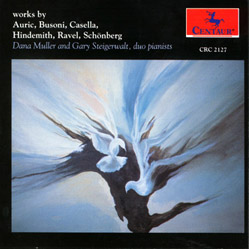 |
Dana Muller & Gary Steigerwalt,
Centaur CD CRC 2127 Recorded August and September 1991 in Chapin and Pratt Auditoriums, Engineer: Jeff Harrison Editing: James C. Hemingway (Busoni, Casella, Ravel); Jeff Harrison Piano Technician: Thomas J. Malone Cover Painting: Sally Muller, [untitled] acrylic on canvas |
| Georges Auric 1899-1983 |
Cinq Bagetelles (1925)
|
| Paul Hindemith 1895-1963 |
Sonata (1938)
|
| Arnold Schönberg 1874-1951 |
Sechs Stücke für Klavier zu vier Händen (1896)
|
| Ferruccio Busoni 1866-1924 |
Finnländische Volksweisen, Op. 27 (1889)
|
| Alfredo Casella (1883-1947) | Pupazetti, Op. 27 (1915)
Pagine di Guerra (1915-19915)
27- Fox Trot (1920) |
| Maurice Ravel (1875-1937) | 28- La Valse (1919-1920) |
Fanfare, November/December 1992, review by James H. North"This duo-piano recital is notable for its exotic variety, even though all the works were written from 1889 to 1938. Auric's Bagatelles are charming, lightweight openers, sounding fresh from Paris music halls. Hindemith's 1938 sonata is a serious, noble work from his central years. . . .
The six brief, early (1896) Schönberg pieces are thoroughly Romantic, with little hint of the composer to come; the notes compare them to Schubert Ländler, but they also have the muscular swing of the young Brahms. Busoni's two Finnish Folksongs develop from simple songs into complex polyphonic pieces with virtuoso codas.
Allfredo Casella's 1915 Pupazzetti ("pieces for marionettes") are spiced with macabre humor, which appears as derisive, even bitter military rhythms in the faster sections (Marcietta, Serenata, Polka) and as world-weary sighing in Berceuse and Notturnino. War Pages, written 1915-19, is even more unusual. The horrors of war are depicted in five separate locales, each using extraordinary, evocative musical means. The five pieces come across as a mixture of Mussorgsky's Pictures at an Exhibition with his Songs and Dances of Death. In 1920 Fox Trot may express relief after the years of war, but its jazzy rhythms still seem infected with a weight of care.
Ravel transcribed his "choreographic poem" La Valse for two pianos; his friend and editor Lucien Garban then arranged it for piano four hands. The result is less demoniacally obsessive than the orchestral original but is a tour-de-force for two pianists. Muller and Steigerwalt--wife and husband--display the incredible variety of musical styles needed to make the most of all these works, as well as the high level of technical fluency required. This is an outstanding disc; after its conclusion, the unusual Casella pieces remain most strongly etched in this listener's memory."
Pan Pipes, Summer 1993, review by Jocelyn Mackey"In this disc, [Muller and Steigerwalt] demonstrate not only technical skill and musical sensitivity, but also an amazing sense of ensemble unity. There is absolute precision of attack, tempo, phrasing and release--only the texture contradicts the hearer's impression that there is one performer. Interpretatively also Muller and Steigerwalt have obviously planned every detail of balance, phrasing, tone with a spirit of one-ness which is heard in the disc. This disc provides refreshingly different repertoire, beautifully played."